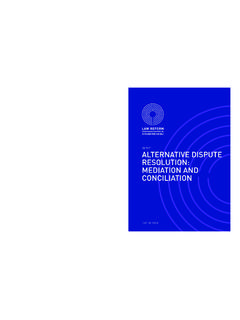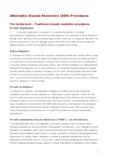Transcription of DEPARTMENT OF HEALTH AND HUMAN SERVICES
1 1 DEPARTMENT OF HEALTH & HUMAN SERVICES Centers for Medicare & Medicaid SERVICES Center for Consumer Information and Insurance Oversight 200 Independence Avenue SW Washington, DC 20201 Date: 12-21-2021 Learn more about the Good Faith Estimate and the Patient-Provider dispute resolution (PPDR) process for people without insurance or who plan to pay for the costs themselves Summary Starting on January 1, 2022, the No Surprises Act1 (NSA) protects uninsured (or self-pay) individuals from many unexpectedly high medical bills. The Act requires that HEALTH care providers and facilities give uninsured (or self-pay) individuals an estimate for the cost of their HEALTH care before the individual agrees to get the item or service.
2 Throughout this document the term providers also includes providers of air ambulance SERVICES People with insurance may also ask for an estimate, which will generally be shared with the insurance plan. If the uninsured (or self-pay) individual is billed for an amount at least $400 above the estimate, the individual may be eligible to start a Patient-Provider dispute resolution (PPDR) process by submitting a request to HHS and paying a small administrative fee. The PPDR process is handled by a third-party company certified by the DEPARTMENT of HEALTH and HUMAN SERVICES (HHS). This company will decide if the estimated amount, or billed amount, or another amount in between the estimated amount and billed amount should be paid.
3 This document contains specific requirements and information about the Good Faith Estimate and PPDR process. Good Faith Estimates for Uninsured (or Self-Pay) Individuals You are generally considered an uninsured or self-pay individual if you do not have HEALTH insurance, or do not plan to use your insurance to pay for a medical item or service. If you are an uninsured or self-pay individual, a provider or facility must give you a good faith estimate detailing what you may be charged before you receive the item or service. The good faith estimate will include: A list of items and SERVICES that the scheduling provider or facility reasonably expects to provide you for that period of care.
4 1 Enacted as part of the Consolidated Appropriations Act, 2021 (Pub. L. 116-260). DEPARTMENT OF HEALTH AND HUMAN SERVICES _____ 2 Beginning in 2023, a list of items and SERVICES and their associated costs, that can bereasonably expected to be given to you by another provider or facility involved in yourcare (a co-provider or co-facility). For example, a doctor probably expects that along withan individual s knee replacement surgery, the patient will also be given anesthesia. Bothof these items and SERVICES should be included in your good faith estimate, and starting in2023, the anesthesia items and SERVICES will have to be included. Applicable diagnosis codes and service codes. Expected charges or costs associated with each item or service from each provider andfacility.
5 A notification that if the billed charges are higher than the good faith estimate, you canask your provider or facility to update the bill to match the good faith estimate, ask tonegotiate the bill, or ask if there is financial assistance available. Information on how to dispute your bill if it is at least $400 higher for any provider orfacility than the good faith estimate you received from that provider or you get a bill that is at least $400 more for any provider of facility than the total expected charges for that provider or facility on the good faith estimate, there is a new patient-provider dispute resolution (PPDR) process available to you. Under the PPDR process, you may request a payment review and decision from an independent company certified by HHS.
6 These companies are referred to as Selected dispute resolution (SDR) entities. The SDR entity will decide what amount you must pay if your bill is at least $400 more for any provider or facility than your good faith estimate from that provider or facility. A summary of important information for this process is provided below. For detailed information, you can review the HHS interim final rules (IFR) titled Requirements Related to Surprise Billing; Part II, published on October 7, 2021. Does the PPDR process apply to people with HEALTH insurance? The PPDR process is set up for: People without HEALTH insurance. People with HEALTH insurance who receive an item or service that isn t covered by theirplan or coverage.
7 People with HEALTH insurance who plan to not use their plan or coverage to pay for aportion or all of the costs for the item or with HEALTH insurance includes those with: A group HEALTH plan (a plan through their employer or union), Group or individual HEALTH insurance coverage offered by a HEALTH insurance issuer, A Federal HEALTH care program (such as Medicaid, Medicare or TRICARE), or A HEALTH benefits plan under a Federal Employees HEALTH Benefits (FEHB) Program. 3 Note: Enrollees in Federal HEALTH care programs are not eligible to receive a good faith estimate as there are other surprise billing protections under these programs. Where can an uninsured (or self-pay) individual find information about a good faith estimate?
8 You should find information about good faith estimates on your provider or facility s website and in the provider or facility s office or on-site where you might schedule items or SERVICES or have questions about your costs. If you have questions about the cost of items or SERVICES , your provider or facility must inform you in writing or orally about requesting a good faith estimate. All of this information must also be available in accessible formats and languages. When can you expect a good faith estimate? If you schedule an item or service at least 3 business days before the date you will receive the item or service, you must be given a good faith estimate no later than 1 business day after scheduling.
9 If you schedule the item or service at least 10 business days before the date you will receive it, or request cost information about an item or service, the provider or facility must give you a good faith estimate no later than 3 business days after scheduling or requesting. Is the good faith estimate a bill? No. The good faith estimate shows the costs of items and SERVICES that your provider or facility expects to charge you for an item or service. The estimate should be based on information known at the time the estimate was created and does not include any unknown or unexpected costs that may arise during the course of treatment. For example an individual could be charged more if complications or special circumstances occur.
10 How will individuals identify items or SERVICES on the Good Faith Estimate? On the good faith estimate you should be able to locate a list of items and SERVICES , grouped by each provider or facility, that includes: Applicable diagnosis codes, Expected service codes, Expected charges associated with each listed item or service for the primary provider or facility (the main provider or facility you are scheduling with), and Any expected charges associated with each listed item or service for the co-providers or co-facilities (the other providers or facilities who will also be a part of your care and bill you separately). Note: In 2022, the good faith estimate may not include all expected charges for items and SERVICES from a co-provider or co-facility for items and SERVICES that are usually expected to be provided along with the primary item(s) or service(s).













